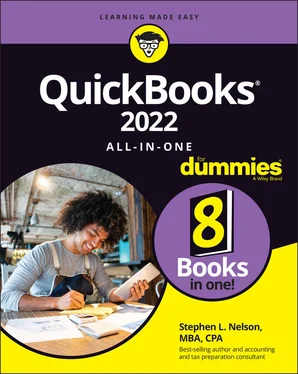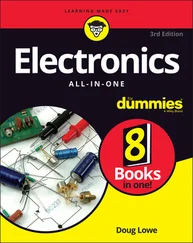Suppose that the first transaction to record is a $1,000 check written to pay rent. In this case, the journal entry appears as shown in Table 2-8. In this example, $1,000 is debited to rent expense, and $1,000 is credited to cash.
TABLE 2-8Journal Entry 4: Recording the Rent Expense
| Account |
Debit |
Credit |
| Rent |
$1,000 |
|
| Cash |
|
$1,000 |
If you need to record $4,000 of wages expense, you use the journal entry shown in Table 2-9. This journal entry debits wages expense for $4,000 and credits cash for $4,000. In other words, you use $4,000 of cash to pay wages for the business.
TABLE 2-9Journal Entry 5: Recording the Wages Expense
| Account |
Debit |
Credit |
| Wages expense |
$4,000 |
|
| Cash |
|
$4,000 |
Recording supplies expense
To record $1,000 of supplies expense paid for by writing a check, you record the journal entry shown in Table 2-10. This transaction debits supplies expense for $1,000 and credits cash for $1,000.
TABLE 2-10Journal Entry 6: Recording the Supplies Expense
| Account |
Debit |
Credit |
| Supplies |
$1,000 |
|
| Cash |
|
$1,000 |
 Note that for each of the preceding transactions, debits equal credits. As long as debits equal credits, you know that the transaction is in balance. This balance is one of the ways that double-entry bookkeeping prevents errors.
Note that for each of the preceding transactions, debits equal credits. As long as debits equal credits, you know that the transaction is in balance. This balance is one of the ways that double-entry bookkeeping prevents errors.
Suppose that you sell $13,000 worth of hot dogs. To record this transaction in a journal entry, you debit cash for $13,000 and credit sales revenue for $13,000, as shown in Table 2-11. I should tell you, however, that in the case of the hot dog stand selling hot dogs for a dollar or two apiece, you wouldn’t necessarily use a single journal entry to record sales revenue amounts. Though you could use a single journal entry that tallied the entire day’s sales, if you’re selling hot dogs at a dollar a dog, you could also record 13,000 $1 transactions. Each of these $1 transactions debits cash for $1 and credits sales revenue for $1.
TABLE 2-11Journal Entry 7: Recording the Sales Revenue
| Account |
Debit |
Credit |
| Cash |
$13,000 |
|
| Sales revenue |
|
$13,000 |
Recording cost of goods sold
You must record the expense of the hot dogs and buns that you sell. You must also record the fact that if you use up your inventory of hot dogs and buns, your inventory balance has decreased. Table 2-12shows how you record these items. Cost of goods sold gets debited for $3,000, and inventory gets credited for $3,000.
TABLE 2-12Journal Entry 8: Recording the Cost of Goods Sold
| Account |
Debit |
Credit |
| Cost of goods sold |
$3,000 |
|
| Inventory |
|
$3,000 |
If you’re confused about this cost-of-goods-sold transaction — it represents the first transaction that doesn’t use cash — read Book 1, Chapter 1, where I describe the two accounting principles. In short, these two principles go like this:
Expense principle: This principle says that an expense gets counted when the item gets sold. This means that the inventory isn’t counted as cost of goods sold or as an expense when it’s purchased. Rather, the expense of each hot dog and bun you sell gets counted when the item is actually sold to somebody.
Matching principle: This principle says that expenses or cost of a sale get matched with the revenue of the sale. This means that you recognize the cost of goods sold at the same time that you recognize the sale. Typically, in fact, you can combine journal entries 7 and 8.
 Another way to think about the information recorded in Journal Entry 8 is this: Rather than spend cash to provide customers hot dogs and buns, you spend inventory.
Another way to think about the information recorded in Journal Entry 8 is this: Rather than spend cash to provide customers hot dogs and buns, you spend inventory.
Recording the payoff of accounts payable
Suppose that one thing you do at the end of the day is write a check to pay off the accounts payable. The accounts payable are the amounts that you owe vendors — probably the suppliers from which you purchased the hot dogs and buns. To record the payoff of accounts payable, you debit accounts payable for $2,000 and credit cash for $2,000, as shown in Table 2-13.
TABLE 2-13Journal Entry 9: Recording the Payoff of Accounts Payable
| Account |
Debit |
Credit |
| Accounts payable |
$2,000 |
|
| Cash |
|
$2,000 |
Recording the payoff of a loan
Suppose also that you use cash profits from the day to pay off the $1,000 loan that the balance sheet shows (refer to Table 2-2earlier in this chapter). To record this transaction, you debit loan payable for $1,000 and credit cash for $1,000, as shown in Table 2-14.
TABLE 2-14Journal Entry 10: Recording the Payoff of the Loan
| Account |
Debit |
Credit |
| Loan payable |
$1,000 |
|
| Cash |
|
$1,000 |
Calculating account balance
You may already be able to guess that if you know an account’s starting balance and have a way to add up the debits and the credits to the account, you can easily calculate the ending account balance.
Take the case of the cash account balance of the hot dog stand. If you look at the balance sheet shown in Table 2-2, you see that the beginning balance for cash is $1,000. You can easily construct a little schedule of how the account balance changes — this schedule is called a T-account — that calculates the ending balance. (In case you’re wondering, a T-account is a visual aid to help in accounting. You start by drawing a big capital T, with debits on the left side and credits on the right side.) In fact, Table 2-15does just this. If you look closely at Table 2-15, you see that the cash beginning balance is $1,000. Then, on the following lines of the T-account, you see the effects of journal entries 4, 5, 6, 7, 9, and 10. Some of these journal entries credit cash. Some of them debit cash. You can calculate the ending cash balance by combining the debit and credit amounts.
TABLE 2-15A T-Account of the Cash Account
|
Debit |
Credit |
| Beginning balance |
$1,000 |
|
| Journal Entry 4 |
|
$1,000 |
| Journal Entry 5 |
|
4,000 |
| Journal Entry 6 |
|
1,000 |
| Journal Entry 7 |
13,000 |
|
| Journal Entry 9 |
|
2,000 |
| Journal Entry 10 |
_____ |
$1,000 |
| Ending balance |
$5,000 |
|
The information shown in Table 2-15should make sense to you. But in case you’re still trying to memorize what debits and credits mean, I’m going to give you a bit more detail. To calculate the ending balance shown in Table 2-15, you add up the debits, add up the credits, and combine the two sums. The net amount in the cash account equals the $5,000 debit. If you recall from the preceding paragraphs, a debit balance in an asset account, such as cash, represents a positive amount. A $5,000 debit balance in the cash account, therefore, indicates that you have $5,000 of cash in the account.
Читать дальше

 Note that for each of the preceding transactions, debits equal credits. As long as debits equal credits, you know that the transaction is in balance. This balance is one of the ways that double-entry bookkeeping prevents errors.
Note that for each of the preceding transactions, debits equal credits. As long as debits equal credits, you know that the transaction is in balance. This balance is one of the ways that double-entry bookkeeping prevents errors.










